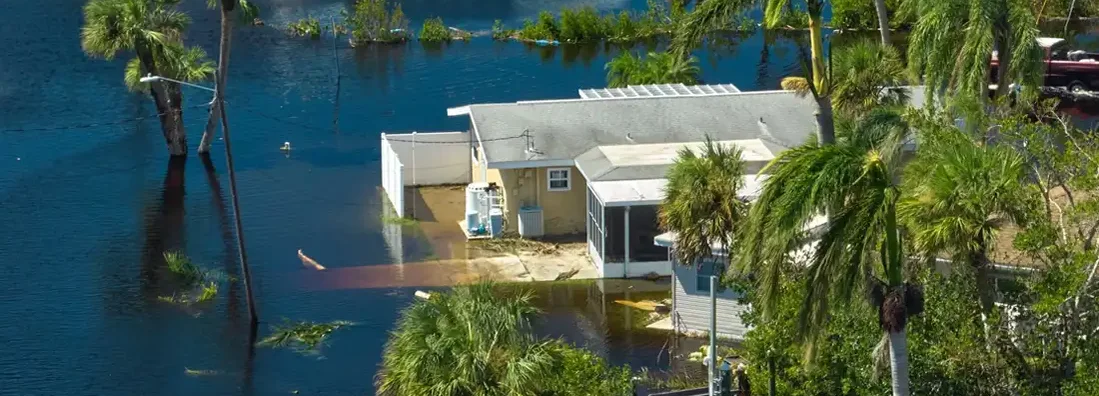What Is a Flood Zone?

People love to be near the water. Whether it’s a river, lake, or sea, a body of water makes for a beautiful landscape and many fun activities. Unfortunately, these bodies of water can also cause flooding. Flooding can happen at any time, no matter where you live (even if you don’t live in a floodplain), so it's important to get educated about floods and flood zones. Read on to learn more about these natural disasters and your risk.
What Is the Definition of a Flood Zone?
A flood zone is an area designated on a Flood Hazard Boundary Map. These geographical areas are given a specific rating depending on the estimated flood risk. A flood zone will determine how much flood insurance will cost and whether or not it is mandatory to carry flood insurance.
Flood Zone vs. Floodplain
So, what is a floodplain, exactly? Floodplain zone definitions refer to floodplains as a Special Flood Hazard Area (SFHA) on Flood Insurance Rate Maps. Floodplain definitions also dictate that an SFHA refers to an area with a 1% chance of being inundated by a flood event that reaches or exceeds base flood elevations within any given year.
A floodplain vs. a flood zone may be easily confused by many individuals, but it's critical to understand the differences so you can be better prepared with the right flood insurance policy for your area.
High-Risk Flood Zones:
- Flood Zone A: You may have wondered, "What is Flood Zone A?" or, "What does 'Flood Zone A' mean?" Flood zones that start with "A" are considered to be at high risk for flooding. These areas are usually along ponds, rivers, and streams.
- Flood Zone V: These areas have not been evaluated for flood risks. The designation "V" is used for high-risk coastal areas, which may receive damage due to flooding and strong waves in storms.
- Flood Zone AE and A1-30: These areas have a 1% chance of inundation by an annual flood event.
- Flood Zone AH: These areas, usually near ponds, have a 1% chance of inundation by an annual shallow flooding event. These flooding events have average depths between one and three feet.
- Flood Zone AO: These areas, usually sheet flow on sloping terrain, have a 1% chance of an annual shallow flooding event. The average depth of these flooding events is between one and three feet.
- Flood Zone AR: These areas exist due to the decertification of a previously accredited flood protection system. This system is actively being restored to offer base flood protection.
- Flood Zone A99: These areas currently have a 1% chance of being inundated by an annual flood event but are under construction of a federal flood protection system, including dams and levees, that will ultimately protect them.
- Flood Zone VE and VI-30: These areas have a 1% chance of inundation by an annual flood event as well as additional hazards caused by wave action due to storm-induced velocity.
Low & Moderate Risk Flood Zones:
- Flood Zone B or Shaded X: These flood zones are considered to be moderate-risk areas.
- Flood Zone C or Un-shaded X: These areas are considered to be at low risk for floods.
- Flood Zone D: These areas have a possibility of flooding, but the specific level of risk is undetermined. Flood hazard analyses haven't been conducted in these areas.
What Is Flood Zone X?
Flood maps include a series of zones that indicate whether an area is prone to a high, moderate, or low flood risk. So, what does Flood Zone X mean? Flood Zone X refers to an area of moderate to low risk, a non-special flood hazard area. This means that the risk of flooding is reduced (compared to a special flood hazard area), but that doesn't eliminate the potential for flooding altogether.
If you live in Flood Zone X, flood insurance isn't federally required. In fact, flood insurance is never federally required. However, you may want to purchase it just in case a flood occurs.
You also might be required to have coverage by your lender, including an FHA or other agencies. If you can't decide whether the flood coverage is worth the cost or which flood zone you're in, talk to an independent insurance agent.
Do Flood Zones Change?
Knowing your current flood zone is important, but you also need to stay updated on any changes in your risk of floods. Environmental changes, new construction, or recurring weather patterns can change your flood zone rating. Changes to your flood zone can lead to higher insurance premium costs. It’s important to reexamine your flood zone risks from time to time to avoid any surprises.
Flooding can happen anywhere, from a coastal seaside home to a business in the middle of the desert. While the chances of flooding in certain areas may be low, a “no risk” flood zone simply doesn't exist. Keep yourself informed about flood zones and your insurance options to get the most protection from this type of natural disaster.
How Do I Find Out My Flood Zone Designation?
There are a few different ways to determine your flood zone designation and risk. One way is to ask a local independent insurance agent because they have access to the latest Flood Insurance Rate Maps. If you're looking to buy a new house, be sure to talk with your agent and realtor about the flood zone risk of the property before you move in.
If you own a home or other property, its flood zone might be listed on the title. If these methods don’t work for you, online flood maps are easily accessible. Many state or city websites have flood maps of local areas for residents to view. FEMA, the Federal Emergency Management Agency, also has flood maps on its website.
For a more personalized assessment, you can hire a surveyor to assess your home for flooding risk. A surveyor will use many different factors to assess your individual risk, including your proximity to bodies of water, your home’s foundation, and the age of your home.
Do I Have to Carry Flood Insurance?
Depending on where you live, flood insurance may be mandatory by your lender. In an "A" or "V" flood zone, flood insurance is often required by lenders, but municipalities themselves don't require coverage.
These are typically areas that are coastal, directly on the waterfront, or near a river. But these could also be areas that receive a high amount of rain throughout the year.
Moderate and low-risk areas may not require you to carry flood insurance, but depending on the weather and the proximity of the area to bodies of water, it might be a good idea to carry flood insurance anyway.
Flood insurance covers rising waters and flood damage, as well as flooding from hurricanes. Homeowners insurance, condo insurance, and mobile home insurance don't typically cover flood damage stemming from these natural sources.
Can I Protect My Business with Flood Insurance?
In addition to residential flood insurance, commercial flood insurance is also available. This insurance protects businesses in case of a flood. Flooding damage can quickly cause over $75,000 of damage to a commercial business.
Many businesses are unable to reopen after a severe flood if they don’t have flood insurance to cover the expenses for cleanup, repairs, and replacement of damaged business collateral, equipment, and furniture. If you own a business or commercial property, adding this insurance can be a wise choice, especially if it's located in an area known to be a flood zone.
More Flood Zone Terminology
Coastal Barrier Resource System (CBRS): These are areas of restricted development along coastlines. These designated areas provide essential barrier protection against flood damage to inland areas.
Flood Insurance Rate Map (FIRM): A map that shows the flood zones and floodplain boundaries for your community. These maps are regularly updated, so talk with an independent insurance agent to get the most updated FIRM for your area.
National Flood Insurance Program (NFIP): The NFIP is a standardized insurance program established by FEMA and offered through insurance agents. As property insurance does not cover flooding, purchasing NFIP flood insurance is the only way to protect yourself financially in the event of most flood damage. There is a 30-day waiting period for flood insurance to take effect. This means you cannot buy flood insurance the day before flooding is predicted and expect to receive coverage.
Special Flood Hazard Area (SFHA): Also known as floodplains, these are areas of land that are designated by FEMA to be at a high risk for flooding.
Flooding Statistics
- Floods are the number one natural disaster in the U.S., causing more deaths and damage than tornadoes and hurricanes.
- The average annual cost of damage due to flooding in the United States is over $2 billion.
- Texas has the most flood-related deaths in the country.
- Flash floods are the most dangerous type of flooding.
- Over half of flood-related deaths are due to attempts to drive through floodwaters.
- Common flooding causes include heavy rainfall, melting snow, and building or structure collapses.
Find Flood Insurance from a Trusted Choice Independent Insurance Agent
Understanding your flood zone designation is only part of the battle. It's also essential to get covered with the right flood insurance policy ASAP to help get the reimbursement you deserve if a flooding disaster hits your area.
Working together with an independent insurance agent can make this process much easier since they can not only shop and compare policies for you but also be there for all your flood insurance questions and needs. These agents can even help you file claims if and when the time comes and help you update your coverage as necessary.
https://www.leegov.com/dcd/flood/defined
https://www.kin.com/glossary/flood-zones/
https://www.floodsmart.gov/understanding-my-flood-zone
https://help.riskfactor.com/hc/en-us/articles/360048256493-Understand-the-differences-between-FEMA-flood-zones
https://community.fema.gov/ProtectiveActions/s/article/Flood-Impact
https://www.pewtrusts.org/en/research-and-analysis/articles/2022/12/15/flooding-is-nearly-a-daily-occurrence-throughout-the-us
https://a-z-animals.com/blog/which-us-states-have-the-most-floods-and-why/
https://www.consumerreports.org/cars/car-safety/the-dangers-of-driving-on-flooded-streets-a8035090841/#:~:text=Over%20half%20of%20flood%2Drelated,and%20the%20National%20Weather%20Service.
